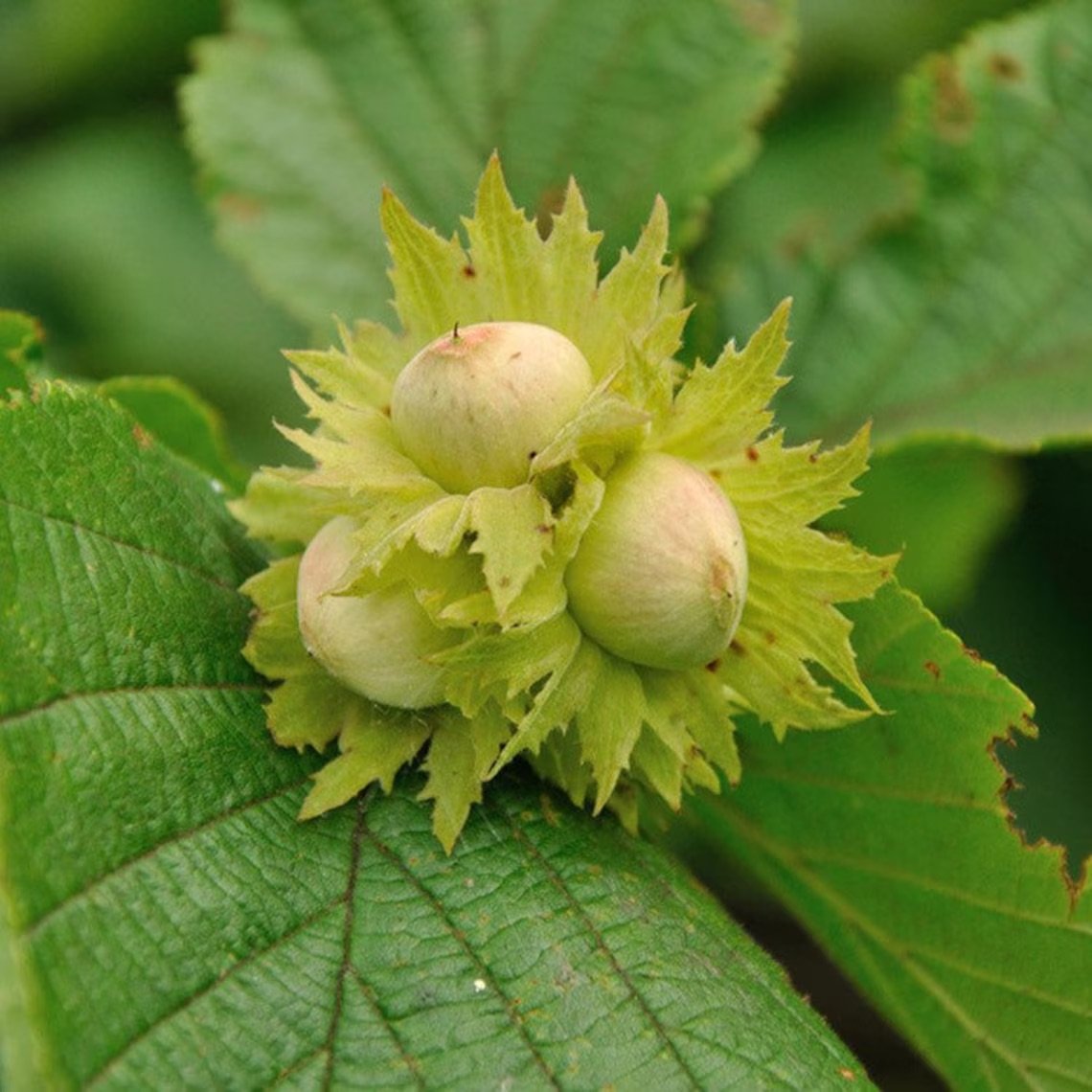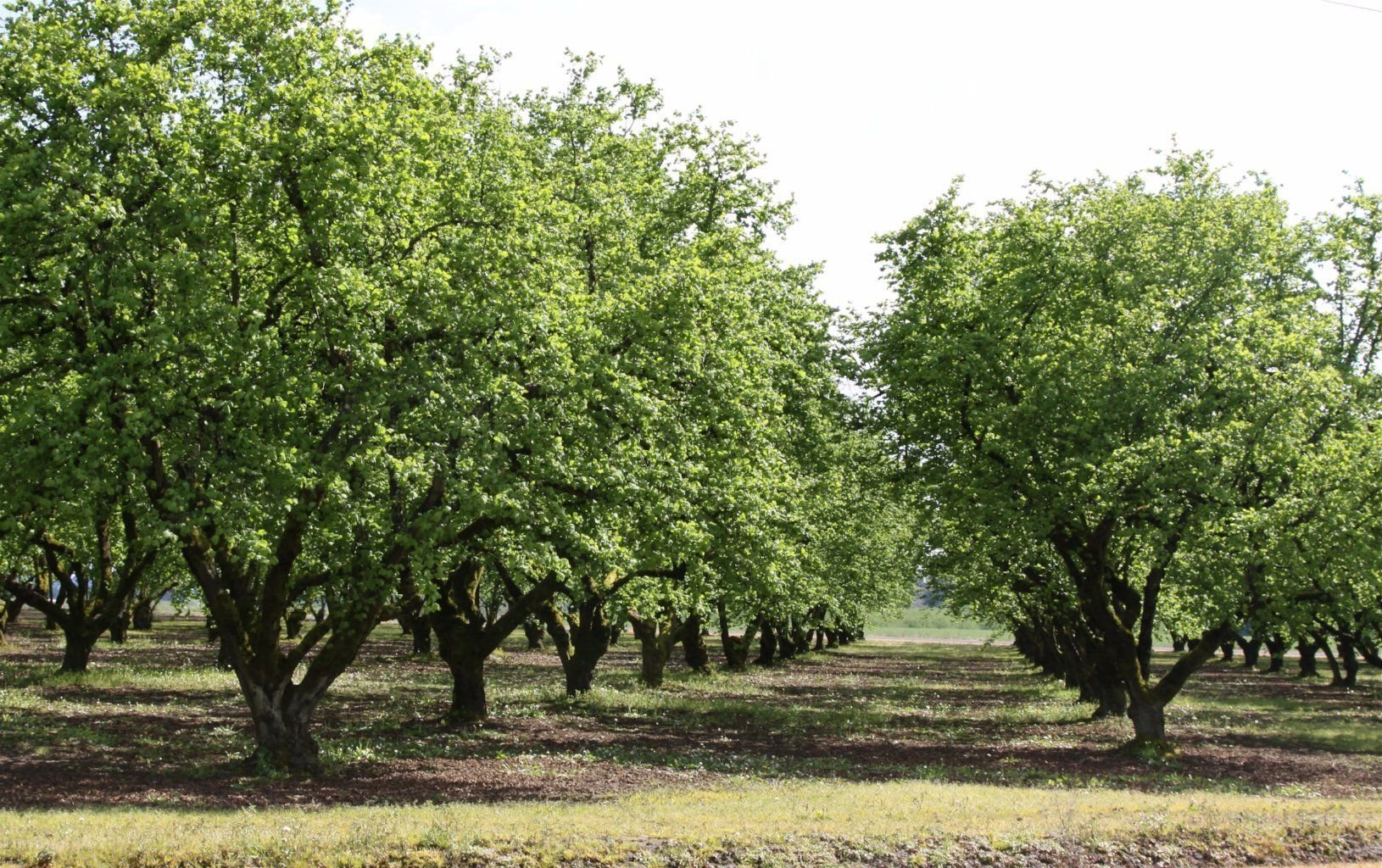Hazelnut
Corylus spp. Hazelnuts are an abundant plant with immense value to wildlife. Native Americans used Corylus americana for medicinal purposes. The best nuts are produced by the filbert cousins, notably the avellana, (common or European) which has been crossed with americana for disease resistance. Common hazelnut It is is used widely in nut production with over 400 known cultivars and famed for its historical use in the hedgerows of the British Isles.
Beyond their inherent value as a nut and oil crop, hazels work wonderfully as an ornamental plant for native plant gardens, and in wildlife gardens to attract and keep fauna. It is a medium to fast-growing species, that suckers moderately, eventually producing a multi-stemmed, clump appearance and reaching varying heights (depending on the species) of up to 25-30 FT tall (sometimes more), though traditionally managed to remain shorter, especially in hedgerows or for production. It adapts well to a range of soil pH and types, but does best on well-drained loams. Prefers full sun for best growth and development, it can grow and persist in partial shade but plant density and fruit production are greatly reduced.
americana: a pure American hazelnut seedling with the highest wildlife value but (likely) the lowest from a nut production standpoint.
Seip Mix: these selections come originally from the feral hedgerows at Robert Seip’s LenniLea farm in Pennsylvania. Excellent hybrid and European dominant hybrid genetics which show no dieback from Eastern Filbert Blight (EFB).
Jefferson: Produces a heavy yield of large, flavorful nuts that fill their shells well. Resistance to Eastern Filbert Blight disease and high resistance to big bud mite. These seedlings were open pollinated with Yamhill and Eta, all blight resistant selections, and will be slower to come into bearing than clones with variable nut size, yield and overall quality. Likely to be vastly superior to average seedling hazelnuts due to their genetics. These are great for hedgerows, erosion control, wildlife plantings and backyard orchardists wanting economical trees.
Sold as bare root trees 12-36” tall.
Corylus spp. Hazelnuts are an abundant plant with immense value to wildlife. Native Americans used Corylus americana for medicinal purposes. The best nuts are produced by the filbert cousins, notably the avellana, (common or European) which has been crossed with americana for disease resistance. Common hazelnut It is is used widely in nut production with over 400 known cultivars and famed for its historical use in the hedgerows of the British Isles.
Beyond their inherent value as a nut and oil crop, hazels work wonderfully as an ornamental plant for native plant gardens, and in wildlife gardens to attract and keep fauna. It is a medium to fast-growing species, that suckers moderately, eventually producing a multi-stemmed, clump appearance and reaching varying heights (depending on the species) of up to 25-30 FT tall (sometimes more), though traditionally managed to remain shorter, especially in hedgerows or for production. It adapts well to a range of soil pH and types, but does best on well-drained loams. Prefers full sun for best growth and development, it can grow and persist in partial shade but plant density and fruit production are greatly reduced.
americana: a pure American hazelnut seedling with the highest wildlife value but (likely) the lowest from a nut production standpoint.
Seip Mix: these selections come originally from the feral hedgerows at Robert Seip’s LenniLea farm in Pennsylvania. Excellent hybrid and European dominant hybrid genetics which show no dieback from Eastern Filbert Blight (EFB).
Jefferson: Produces a heavy yield of large, flavorful nuts that fill their shells well. Resistance to Eastern Filbert Blight disease and high resistance to big bud mite. These seedlings were open pollinated with Yamhill and Eta, all blight resistant selections, and will be slower to come into bearing than clones with variable nut size, yield and overall quality. Likely to be vastly superior to average seedling hazelnuts due to their genetics. These are great for hedgerows, erosion control, wildlife plantings and backyard orchardists wanting economical trees.
Sold as bare root trees 12-36” tall.
Corylus spp. Hazelnuts are an abundant plant with immense value to wildlife. Native Americans used Corylus americana for medicinal purposes. The best nuts are produced by the filbert cousins, notably the avellana, (common or European) which has been crossed with americana for disease resistance. Common hazelnut It is is used widely in nut production with over 400 known cultivars and famed for its historical use in the hedgerows of the British Isles.
Beyond their inherent value as a nut and oil crop, hazels work wonderfully as an ornamental plant for native plant gardens, and in wildlife gardens to attract and keep fauna. It is a medium to fast-growing species, that suckers moderately, eventually producing a multi-stemmed, clump appearance and reaching varying heights (depending on the species) of up to 25-30 FT tall (sometimes more), though traditionally managed to remain shorter, especially in hedgerows or for production. It adapts well to a range of soil pH and types, but does best on well-drained loams. Prefers full sun for best growth and development, it can grow and persist in partial shade but plant density and fruit production are greatly reduced.
americana: a pure American hazelnut seedling with the highest wildlife value but (likely) the lowest from a nut production standpoint.
Seip Mix: these selections come originally from the feral hedgerows at Robert Seip’s LenniLea farm in Pennsylvania. Excellent hybrid and European dominant hybrid genetics which show no dieback from Eastern Filbert Blight (EFB).
Jefferson: Produces a heavy yield of large, flavorful nuts that fill their shells well. Resistance to Eastern Filbert Blight disease and high resistance to big bud mite. These seedlings were open pollinated with Yamhill and Eta, all blight resistant selections, and will be slower to come into bearing than clones with variable nut size, yield and overall quality. Likely to be vastly superior to average seedling hazelnuts due to their genetics. These are great for hedgerows, erosion control, wildlife plantings and backyard orchardists wanting economical trees.
Sold as bare root trees 12-36” tall.




